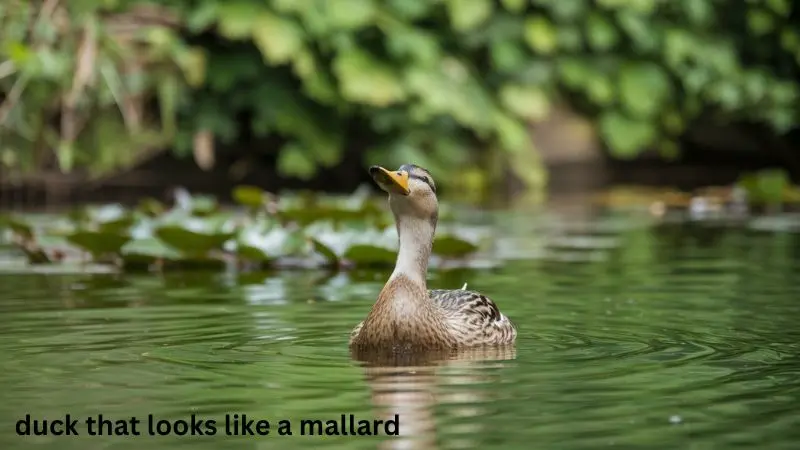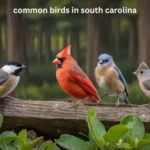Before diving into the ducks that resemble mallards, it is essential to understand the key traits that make the mallard a model for comparison. Mallards are the most widespread and recognizable wild duck species, found across Europe, North America, and parts of Asia. Their distinctive appearance serves as a reference point for identifying other similar species. In this article from Bird01.com, let’s explore duck that looks like a mallard!
Key Characteristics of Mallards:
- Male Mallard: The male mallard, known for its glossy green head, bright yellow bill, white neck ring, and chestnut-brown chest, stands out in any waterfowl crowd. Its gray body, black rump, and curly tail feathers add to its iconic look. The iridescent blue wing patch, bordered by white lines, is visible during flight.
- Female Mallard: The female mallard, though less colorful, has a warm brown, mottled appearance that provides excellent camouflage. Her bill is orange with darker markings, and like the male, she also displays the signature blue wing patch.
The mallard’s widespread distribution and adaptability to various habitats, including urban parks, wetlands, and marshes, contribute to its prominence. Mallards are dabbling ducks, meaning they feed primarily by tipping forward to forage in shallow water rather than diving.
Duck That Looks Like A Mallard: Mallard Look-Alikes
Several duck species share physical traits with the mallard, often leading to confusion in identification. However, a closer examination reveals subtle differences in plumage, size, and behavior. Below, we explore some of the most notable mallard look-alikes.
American Black Duck (Anas rubripes)
The American black duck is one of the closest relatives of the mallard and is often mistaken for the female mallard due to its similar brownish coloring. However, the American black duck is darker overall and has a more uniform chocolate-brown appearance.
Distinguishing Features:
- Plumage: The American black duck’s plumage is a deep, dark brown, almost appearing black in some lighting, which distinguishes it from the lighter female mallard. The contrast between the body and head is less pronounced.
- Bill Color: Male and female American black ducks have yellow or olive-colored bills, contrasting with the orange bills of female mallards.
- Habitat: Black ducks are commonly found in eastern North America and prefer more secluded and wooded wetlands compared to the mallard.
Although they look similar, hybridization between mallards and black ducks is common, leading to offspring with mixed characteristics, further complicating identification.
Northern Pintail (Anas acuta)
Another mallard look-alike is the Northern pintail, a slender and graceful species that shares some visual traits with mallards but differs in several ways.
Distinguishing Features:
- Male Pintail: The male Northern pintail is distinguished by its elongated neck, pointed tail feathers, and chocolate-brown head. While its body is grayish, similar to the male mallard, the pintail’s streamlined shape and long tail make it easy to differentiate.
- Female Pintail: Female pintails resemble female mallards but have a more slender appearance and a slightly longer neck. Their plumage is also more uniform, with less mottling than female mallards.
- Behavior: Northern pintails are elegant flyers and often prefer more open habitats such as shallow wetlands and agricultural fields.
Pintails are migratory and can be found in both the Northern and Southern Hemispheres, making them one of the most widespread duck species globally.

Gadwall (Mareca strepera)
Gadwalls are another species that can be mistaken for mallards, especially the females. However, both male and female gadwalls have distinct features that set them apart.
Distinguishing Features:
- Male Gadwall: The male gadwall lacks the bright coloration of the male mallard. Instead, it has a subtle, understated plumage with fine gray and brown patterns. Its wing features a striking white patch, easily seen during flight.
- Female Gadwall: Female gadwalls closely resemble female mallards but are generally lighter in color and have a more streamlined shape. Their bills are typically darker, lacking the orange hue of mallard females.
- Behavior: Gadwalls are dabbling ducks like mallards but are more commonly found in deeper wetlands and marshes.
While not as widespread as mallards, gadwalls are common in North America and Europe, and their subtle beauty makes them a favorite among birdwatchers.
Mottled Duck (Anas fulvigula)
The mottled duck, native to the southeastern United States, bears a strong resemblance to the female mallard but has several key differences that make it unique.
Distinguishing Features:
- Plumage: The mottled duck has a uniform brownish body with less distinct mottling than the female mallard. Its overall appearance is darker, especially around the head and neck.
- Bill Color: One of the most striking differences is the bill color. Male mottled ducks have bright yellow bills, while females have duller olive bills, distinguishing them from mallards.
- Habitat: Mottled ducks are non-migratory and prefer coastal marshes, shallow lakes, and ponds in the southeastern U.S.
Like the American black duck, mottled ducks occasionally hybridize with mallards, resulting in hybrids that exhibit traits of both species.
Mexican Duck (Anas diazi)
Closely related to both the mallard and the American black duck, the Mexican duck is another species often mistaken for the female mallard.
Distinguishing Features:
- Plumage: The Mexican duck has a darker, more uniform brown body than the female mallard, with less contrast between the body and head. Its plumage is closer in appearance to the American black duck.
- Size and Shape: Mexican ducks are generally smaller and more compact than mallards, with shorter necks and less pronounced white markings on their wings.
- Distribution: Found mainly in Mexico and the southwestern United States, Mexican ducks are less commonly encountered than mallards but share similar habitats.
The Mexican duck is another species that frequently hybridizes with mallards, contributing to the difficulty of distinguishing between the two.
Mallard Hybrids: A Common Confusion
As mentioned with several species above, hybridization is a common occurrence among ducks, especially mallards. Because mallards are so widespread and adaptable, they often mate with other species, producing hybrids that combine characteristics of both parent species.
Common Mallard Hybrids:
- Mallard x American Black Duck: These hybrids can exhibit a mix of dark and light plumage, combining the dark brown of the black duck with the more colorful markings of the mallard.
- Mallard x Mottled Duck: Hybrids between mallards and mottled ducks often have a brownish appearance, with varying degrees of mottling and bill coloration that can make identification challenging.
- Mallard x Northern Pintail: These hybrids often retain the pintail’s slender body and tail shape while adopting some of the mallard’s coloration.
Hybrid ducks present a unique challenge for birdwatchers, as their traits can vary widely depending on the parent species involved. Observers must rely on subtle clues such as bill color, plumage patterns, and behavior to identify hybrids accurately.
The Importance of Correct Identification
For birdwatchers, researchers, and conservationists, accurately identifying duck species is essential. While mallards and their look-alikes may share similarities, recognizing their differences is crucial for understanding their behaviors, population dynamics, and ecological roles.
Why It Matters:
- Conservation: Some mallard look-alikes, such as the American black duck, are of conservation concern due to habitat loss and hybridization with mallards. Accurate identification helps monitor their populations and ensure appropriate conservation efforts.
- Ecology: Different duck species play various roles in their ecosystems, from seed dispersal to maintaining wetland health. Identifying these species helps researchers study their impact on habitats.
- Birdwatching: For birdwatchers, distinguishing between similar species is a rewarding challenge that enhances their appreciation of the natural world.
Conclusion
The world of ducks that look like mallards is full of fascinating species, each with its unique characteristics and role in the environment. From the dark-plumaged American black duck to the sleek and elegant Northern pintail, these mallard look-alikes offer endless opportunities for observation and study.
As we continue to explore the diversity of the avian world, it becomes clear that while some ducks may resemble mallards, they each bring something special to the table. Whether you’re a seasoned birdwatcher or a novice nature enthusiast, taking the time to appreciate these subtle differences will deepen your understanding of the world around you.
This article has been brought to you by Bird01.com, your go-to source for all things bird-related. Keep exploring, keep observing, and most importantly, keep enjoying the beauty of nature’s feathered wonders.





